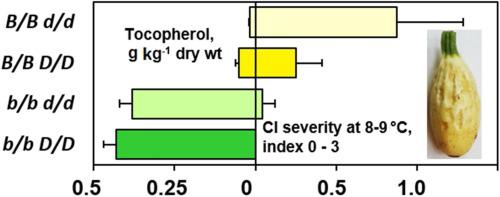当前位置:
X-MOL 学术
›
Postharvest Biol. Technol.
›
论文详情
Our official English website, www.x-mol.net, welcomes your feedback! (Note: you will need to create a separate account there.)
Chilling sensitivity of four near-isogenic fruit-color genotypes of summer squash (Cucurbita pepo, Cucurbitaceae) and its association with tocopherol content
Postharvest Biology and Technology ( IF 7 ) Pub Date : 2020-10-01 , DOI: 10.1016/j.postharvbio.2020.111279 Victor Rodov , Harry S. Paris , Haya Friedman , Mitiku Mihiret , Yakov Vinokur , Anton Fennec
Postharvest Biology and Technology ( IF 7 ) Pub Date : 2020-10-01 , DOI: 10.1016/j.postharvbio.2020.111279 Victor Rodov , Harry S. Paris , Haya Friedman , Mitiku Mihiret , Yakov Vinokur , Anton Fennec

|
Abstract Accessions of Cucurbita pepo vary in the sensitivity of their young fruit (summer squash) to chilling injury (CI). The dominant gene B (Bicolor), which confers yellow fruit coloration, is known to increase susceptibility of summer squash to CI as compared with green, b/b, fruit. Another dominant gene, D (Dark stem), confers dark plant stems and somewhat enhanced coloration of the young fruit. However, the effect of this gene on chilling sensitivity of summer squash is unknown. Freshly harvested fruit of vegetable marrow-type summer squash from four near-isogenic genotypes, B/B D/D, B/B d/d, b/b D/D, and b/b d/d, were stored for 14 d at three temperature regimes, 4–5, 8–9, and 11–12 °C. Storage at 4–5 °C resulted in CI development in the fruit of all four genotypes. The yellow, B/B genotypes suffered injury also at 8–9 °C, especially the fruit of the light yellow, B/B d/d genotype that showed slight CI symptoms even at 11–12 °C. Chilling tolerance of the genotypes was in accordance with the total tocopherol contents of their exocarp, being highest in the green-skinned b/b accessions and lowest in the light yellow B/B d/d genotype. Relatively higher tocopherol content and lower CI severity were observed in the fruit of the enhanced-yellow B/B D/D genotype. The dominant D allele can partially alleviate the CI sensitivity of summer squash that is conferred by the dominant B allele.
中文翻译:

西葫芦(Cucurbita pepo,Cucurbitaceae)四种近等基因果实颜色基因型的低温敏感性及其与生育酚含量的关系
摘要 西葫芦的种质在其幼果(西葫芦)对冷害(CI)的敏感性方面存在差异。已知显性基因 B (Bicolor) 赋予黄色果实着色,与绿色 b/b 果实相比,已知可增加西葫芦对 CI 的易感性。另一个显性基因 D(暗茎)赋予植物茎暗色和稍微增强的幼果着色。然而,该基因对西葫芦寒冷敏感性的影响尚不清楚。来自四种近等基因基因型 B/BD/D、B/B d/d、b/b D/D 和 b/bd/d 的蔬菜骨髓型西葫芦的新鲜果实在三个温度范围,4–5、8–9 和 11–12 °C。在 4–5 °C 下储存导致所有四种基因型果实的 CI 发育。黄色、B/B 基因型也在 8-9°C 下受到伤害,特别是浅黄色、B/B d/d 基因型的果实,即使在 11-12°C 也表现出轻微的 CI 症状。基因型的耐寒性与其外果皮的总生育酚含量一致,在绿皮 b/b 种质中最高,在浅黄色 B/B d/d 基因型中最低。在增强型黄色 B/BD/D 基因型的果实中观察到相对较高的生育酚含量和较低的 CI 严重程度。显性 D 等位基因可以部分减轻显性 B 等位基因赋予的西葫芦 CI 敏感性。在绿皮 b/b 种质中最高,在浅黄色 B/B d/d 基因型中最低。在增强型黄色 B/BD/D 基因型的果实中观察到相对较高的生育酚含量和较低的 CI 严重程度。显性 D 等位基因可以部分减轻显性 B 等位基因赋予的西葫芦 CI 敏感性。在绿皮 b/b 种质中最高,在浅黄色 B/B d/d 基因型中最低。在增强型黄色 B/BD/D 基因型的果实中观察到相对较高的生育酚含量和较低的 CI 严重程度。显性 D 等位基因可以部分减轻显性 B 等位基因赋予的西葫芦 CI 敏感性。
更新日期:2020-10-01
中文翻译:

西葫芦(Cucurbita pepo,Cucurbitaceae)四种近等基因果实颜色基因型的低温敏感性及其与生育酚含量的关系
摘要 西葫芦的种质在其幼果(西葫芦)对冷害(CI)的敏感性方面存在差异。已知显性基因 B (Bicolor) 赋予黄色果实着色,与绿色 b/b 果实相比,已知可增加西葫芦对 CI 的易感性。另一个显性基因 D(暗茎)赋予植物茎暗色和稍微增强的幼果着色。然而,该基因对西葫芦寒冷敏感性的影响尚不清楚。来自四种近等基因基因型 B/BD/D、B/B d/d、b/b D/D 和 b/bd/d 的蔬菜骨髓型西葫芦的新鲜果实在三个温度范围,4–5、8–9 和 11–12 °C。在 4–5 °C 下储存导致所有四种基因型果实的 CI 发育。黄色、B/B 基因型也在 8-9°C 下受到伤害,特别是浅黄色、B/B d/d 基因型的果实,即使在 11-12°C 也表现出轻微的 CI 症状。基因型的耐寒性与其外果皮的总生育酚含量一致,在绿皮 b/b 种质中最高,在浅黄色 B/B d/d 基因型中最低。在增强型黄色 B/BD/D 基因型的果实中观察到相对较高的生育酚含量和较低的 CI 严重程度。显性 D 等位基因可以部分减轻显性 B 等位基因赋予的西葫芦 CI 敏感性。在绿皮 b/b 种质中最高,在浅黄色 B/B d/d 基因型中最低。在增强型黄色 B/BD/D 基因型的果实中观察到相对较高的生育酚含量和较低的 CI 严重程度。显性 D 等位基因可以部分减轻显性 B 等位基因赋予的西葫芦 CI 敏感性。在绿皮 b/b 种质中最高,在浅黄色 B/B d/d 基因型中最低。在增强型黄色 B/BD/D 基因型的果实中观察到相对较高的生育酚含量和较低的 CI 严重程度。显性 D 等位基因可以部分减轻显性 B 等位基因赋予的西葫芦 CI 敏感性。



























 京公网安备 11010802027423号
京公网安备 11010802027423号